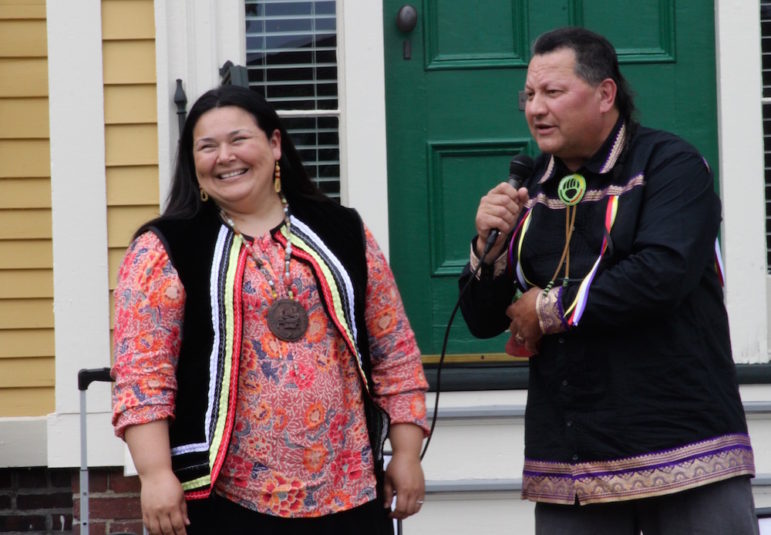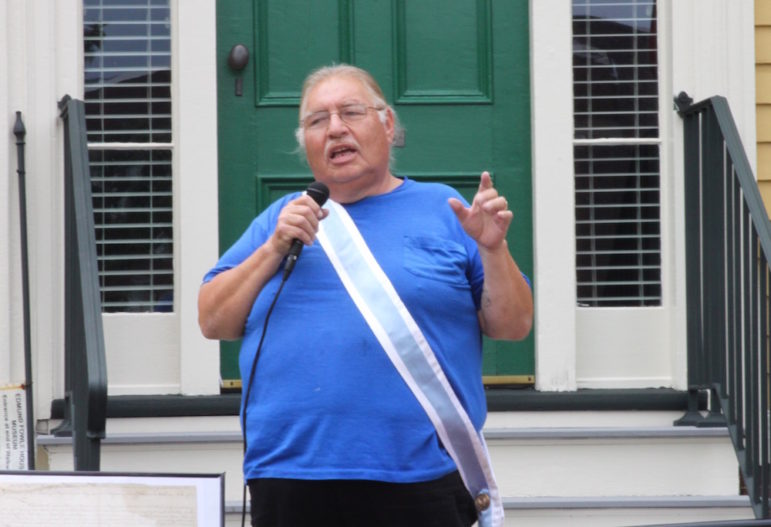
Charlie Breitrose
Members of the United Native American Cultural Center in Devens play a traditional Native American song as part of the celebration of the signing of the Treaty of Watertown and the first reading of the Declaration of Independence at Watertown’s Edmund Fowle House.
Descendants of the Native Americans who signed the Treaty of Watertown, the first treaty made by the newly independent United States, took part in the celebration of the signing that took place right here in Watertown 241 years ago.
Each year the Historical Society of Watertown celebrates Treaty Day, in honor of the treaty signed on July 19, 1776, as well as another date of significance in Massachusetts – the first reading of the Declaration of Independence to Watertown residents on July 18, 1776. The celebration takes place at the building where both events took place, the Edmund Fowle House on Marshall Street, half a off Mt. Auburn Street.
On Saturday, local re-enactors were joined by members of the Indian tribes – the Mi’kmaq and Maliseet – which signed the Treaty of Watertown. For the first time in centuries a chief of the Maliseet, who were known then as the St. John Indians, returned to the place where the treaty was signed.
Two years ago, Henry Bear, whose ancestor Ambrose Bear had been one of the Maliseet to sign the Treaty, came to Watertown for the first time to attend the Treaty Day celebration.

Charlie Breitrose
Members of the Historical Society of Watertown, and historic re-enactors Bob Childs and Steve Steadman say “hazzah” after the read of the Declaration of Independence at Saturday’s event.
This year, Bear returned and he honored Clarissa Sabattis, Chief of the Houlton Band of Maliseet. There are seven Maliseet bands and their land straddles the US-Canada border and includes parts of Maine and New Brunswick. For being the first chief to take part in the celebration, Bear presented Sabattis with a replica of the medallion that Bear had been presented by Chief Roland Jerome of the United Native American Cultural Center – who for years served as the representative in the reenactment of the tribes which signed the treaty. He presented the medallion when Bear, a member of the Maliseet, first attended the ceremony.
Sabattis joked that one thing she struggled with when coming to the event was what shoes to wear. Normally the moccasins are worn during traditional ceremonies, such as when the chiefs of the all the Maliseet bands meet, she said.
“It is not a traditional ceremony, but at least in a way we are celebrating,” Sabattis said. “I said, of course, I’m going to wear the moccasins.”

Charlie Breitrose
Clarissa Sabattis was the first Maliseet chief to return to the place where the Treaty of Watertown was signed since the document’s signing. She received a medallion from Henry Bear, a Maliseet and descendant of one of the original signers of the treaty.
Sabattis had worked with Bear on other issues, and had heard about the celebration in Watertown. She was only recently elected chief, which is a four-year term.
“I am trying to get our tribe more connected with its history and culture,” Sabattis said. “I think this is great. I want to bring it home and bring it to my people. I hope to bring more people next year.”
Members of the Mi’kmaq drove 11 hours from Nova Scotia to attend the ceremony, and intended to turn around and head back after it was over. Russel Julian, a captain of the Mi’kmaq said he was honored to be at the Treaty Day celebration.
“I am not a doctor, I am not a lawyer, but I have a master’s degree right here in my heart,” Julian said. “We love our country, we love America. I thank everyone for coming out to celebrate this very important day.”
At the time of the signing, the Treaty allied the Indian tribes with the U.S. during the Revolutionary War. However, it also had impacts on other areas, such as trade and commerce. These still have repercussions today. Bear, who is also a member of the House of Representatives in Maine, said he spends a lot of time trying to make sure that the Maliseet’s rights from the treaty are respected, including fishing rights, for instance.

Charlie Breitrose
Russel Julian, a member of the Mi’kmaq tribe, one of the tribes to sign the Treaty of Watertown, attended the event held at the house where the treaty was signed in 1776.
The treaty could not be signed until the colonies declared their independence from Great Britain. While the Declaration was signed on July 4, 1776, it was delayed getting to Watertown, which was the Massachusetts General Court – or legislature – met from 1775-76. Watertown’s Marilyn Petitto Devaney currently serves on the Governor’s Council – the group that signed the first treaty.
These days, the Governor’s Council has a different role. Its members review appointments of the governor to a wide range of positions: judges, clerk magistrates, members of the Parole Board, Appellate Tax Board, Industrial Accident Board and Industrial Accident Reviewing Board, notaries, and justices of the peace.
Devaney said that it was great to be at the Fowle House to celebrate the two historic events, but that for several years people could not even go up to the second floor. This is where the Governor’s Council met, and where the Treaty was signed and from where the Declaration of Independence was read by the Town Crier.
“For (years) we could not go up there to see the chambers, it was not safe,” Devaney said. “Thanks to Gov. Romney for giving us the money (to repair the house). I told him it is not just Watertown’s history, it is the state’s history.”
The second floor was closed in 2000 and 2001, according to Joyce Kelly of the Historical Society, and was renovated in 2004.

I am a descendant of one of the signers, Roger Sherman from Connecticut. I live in Watertown.
Thanks for letting us know, Martha. If you haven’t attended one of the Treaty Day celebrations you should come out to one.